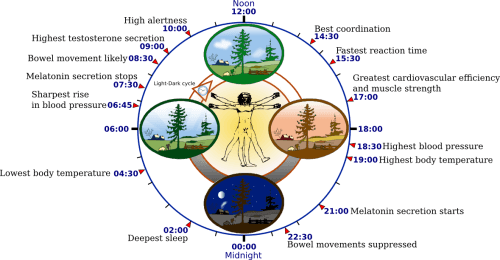Scientists from the Weizmann Institute have discovered a new method that may help those suffering from jet-lag, through the use of oxygen capable of synchronizing the biological clocks in the body.

Most animals, including humans, are able to measure time using an internal biological clock. But when people fly to distant destinations that exist in a new time zone, they experience a mismatch between their body's "biological clock" and their external clock. The result is a disturbance in the biological clock - or, in other words - "flying" (jet-lag).
Now, a new method developed by scientists at the Weizmann Institute of Science may offer a solution to people suffering from epilepsy as well as other disorders resulting from a disruption in the activity of the biological clock. The method, which is based on exposure to oxygen-thin air, was proven to be effective in an experiment on mice and was recently described in the scientific journal Cell Metabolism.
"We saw that in mice exposed to changes in oxygen levels, flight was significantly shortened," says Dr. Gad Asher from the Department of Biomolecular Sciences, who heads the research group. The research was led by Dr. Yarit Adamovich Tamm and the post-doctoral researcher Dr. Benjamin Ladock. Dr. Marina Gulik from Dr. Asher's laboratory and Dr. Marten Conners, from the University of Bristol, United Kingdom, were also partners in the study.
The scientists wanted to trace the biological signal that enables the synchronization of all the clocks in the body. "The biological clock consists of millions of clocks found in every organ and cell in the body," explains Dr. Adamovich Tamm. "We wanted to understand what is the thing that enables the coordination between them, so that they tick in harmony." Metabolism and temperature - as scientists know - are both related to oxygen consumption and are known to be dominant factors in synchronizing the body's clocks. In light of this, they set out to test whether oxygen might also be a synchronizing signal for body clocks.
"There are three requirements for such a hundred," explains Dr. Asher. "First, the cells of the body need to recognize it; Second, it should have a daily rhythm - that is, it should reach a peak level every 24 hours and thus convey a 'message' about the time; And thirdly, it must affect all the cells of the body and make them display the same time."
Oxygen is recognized by most of the body's cells, and therefore definitely meets the first requirement. But what about the other requirements? In an experiment they conducted with mice, the scientists saw that oxygen consumption and its presence in the blood has a daily rhythm. "It was important for us to understand if these daily changes are also felt by the tissues in the animal," says Dr. Ladwicks. For this purpose, the scientists used the technology available in Dr. Conners' laboratory - an electrode that is implanted in the kidney of a rat, and monitors the oxygen levels in it, while the animal moves freely in the cage. "We saw that the oxygen levels in the kidney move in a daily rhythm - that is, they reach a peak every day," says Dr. Asher.

Finally, the scientists examined whether a daily change in oxygen levels is able to "tell" the clocks what time it is - which would meet the third requirement. For this purpose, they exposed a tissue culture whose clocks are not synchronized to changing levels of oxygen in a way that mimics the situation in an animal. As they expected, they found that this exposure caused the cells' clocks to synchronize while the clocks in the control group, which were kept at a constant oxygen level, were not synchronized.
"We showed that oxygen is able to cause clock synchronization - an effect that has never been studied or described in the context of biological clocks," says Dr. Asher. Following this, the scientists discovered that the process depends on a protein that encourages gene expression and is itself affected by oxygen and is called HIF1.
The last step included the application of the "in the field" signal. For this purpose, the scientists artificially changed the biological clocks of the mice, with the aim of making them fly. "We changed the light and dark regime of the mice, which caused them to jump six hours forward in time. This situation simulates a flight from Israel to one of the countries of the Far East", explains Dr. Adamovich Tamm.
Near the Yafat Shehu, one group of mice was exposed to low oxygen levels for several hours. Another group - which served as a control group - was exposed to a constant level of oxygen. The result: the mice in the first group had a significantly shorter flight compared to the control group.
"We showed that changes in oxygen levels are capable of synchronizing biological clocks in mice and significantly improving recovery time from stroke," says Dr. Asher. "Can we see this effect in humans as well? This question is still open."
He further adds: "These are exciting results both in the scientific aspect and in regards to the applied potential inherent in the discovery. Now, for example, we are testing whether oxygen-rich air can also lead to an improvement in breathing. If the method turns out to be effective in humans, we can think of simple solutions for its application; For example - using an oxygen mask on a plane."

One response
strange. If in the experiment they actually reduced the amount of oxygen, why do you think that increasing the amount will cause the same effect? And why didn't they try it on the same mice?